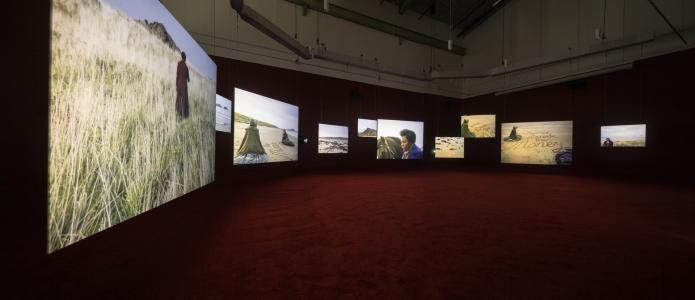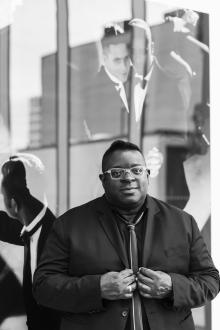Back
Isaac Julien, Lessons of the Hour — Frederick Douglass
Isaac Julien, Lessons of the Hour — Frederick Douglass
August 09, 2023 to December 10, 2023
This fall in the Schnitzer Gallery the JSMA presents Isaac Julien’s Lessons of the Hour—Frederick Douglass, a breathtaking meditation on the great 19th-century abolitionist. Julien’s immersive 10-screen film installation collapses time and space, alternating between contemplative, poetic sequences reflecting Douglass’s long life and travels, and moments of passionate political oratory. In Lessons, Julien has created a profoundly powerful, resonating art experience that brings Douglass thrillingly to life, making clear the importance of his legacy and the continuing relevance of his political voice and moral vision.
Born in 1818, Frederick Douglass escaped slavery and went on to become a masterful writer and orator. He was one of history’s greatest activists for freedom and equality, and an early advocate for women’s suffrage. The author of three important autobiographies written to advocate for abolition, Douglass used both his incredible life story, eloquence, and the power of his image to combat the dehumanizing depictions of Black Americans used to justify slavery. In doing so, he became the most photographed individual of the 19th century.
Julien’s video narrative is informed by Douglass’s powerful speeches. It includes excerpts from “Lessons of the Hour,” “What to the Slave Is the 4th of July?,” and the prescient “Lecture on Pictures,” which examines the emergence of photography and its potential to influence human relations. Ray Fearon, a British Shakespearean actor, portrays Douglass within the film, delivering Douglass’s words with a nuanced precision and passionate fire that bring the great historical figure rivetingly to life. Around Fearon/Douglass’s magisterial visage, Julien weaves passages of Douglass’s writings and filmed reenactments of the abolitionist’s travels in the United States, Scotland, and Ireland. These are interspersed with contemporary protest footage that makes Douglass’s modern-day relevance and resonance both palpable and undeniable.
Lessons of the Hour is presented across 10 video screens of varying sizes, creating a 29-minute, mesmerizingly lush, ever-changing montage of image and sound. It includes sequences shot in Washington, D.C., at The Frederick Douglass National Historic Site, where Douglass lived late in life, and where his house in Cedar Hill has been kept conserved as it was during the abolitionist's time. Other sequences were filmed in Scotland, where Douglass was an active member of the "Send Back the Money" movement and delivered anti-slavery speeches, and in London's Royal Academy of Arts, to an audience which includes both 19th century characters, and contemporary, real-life scholars and Royal Academicians. The installation is accompanied by a significant catalogue available in the JSMA store, including scholarly essays by Henry Louis Gates, Deborah Willis, and others.
Born in the London’s East End to parents who migrated from the Caribbean island of Saint Lucia, Isaac Julien is an internationally renowned filmmaker and artist whose work has been shown in major exhibitions and film festivals since the 1990s and collected by museums world-wide. Before focusing on video installations such as Lessons of the Hour, he became known for early films such as Looking for Langston (1989), about the Harlem Renaissance figure Langston Hughes, and Young Soul Rebels (1991), which won the Semaine de la Critique prize for best film at the Cannes Film Festival. His films, photography, single-channel and multi-screen video installations will be featured in Isaac Julien, What Freedom Means to Me, a retrospective exhibition from April 23 to August 20, 2023 at the Tate Gallery in London, surveying his work across four decades. In 2022 Queen Elizabeth knighted Julien “for services to diversity and inclusion in art.” He divides his time between his London studio and the University of California, Santa Cruz, where he is a distinguished professor of the arts.







